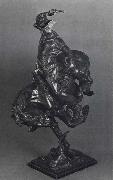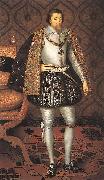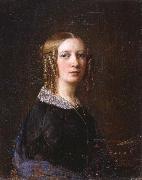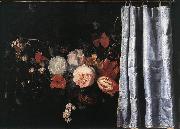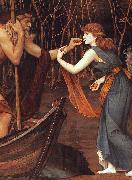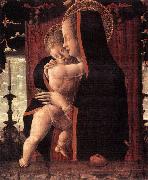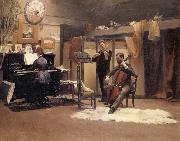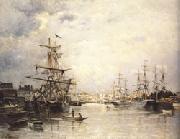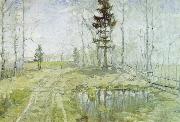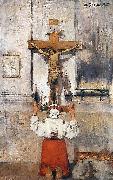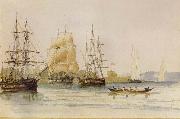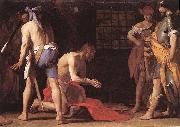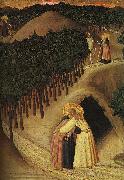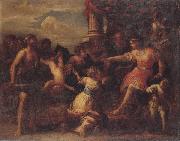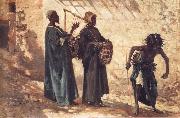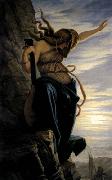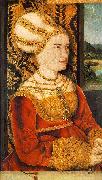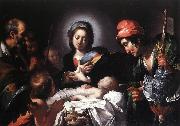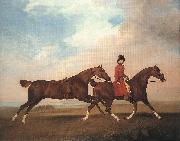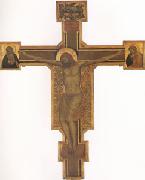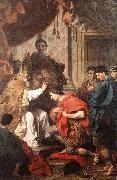|
|
|
|
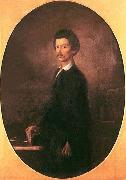 |
Soma Orlai Petrich
|
|
(October 22, 1822, Mezőbereny - June 5, 1880, Budapest) was a Hungarian painter. Petrich was born to a Serbian father and Hungarian mother.
He originally wanted to become a writer. He was a pupil of Jakab Marastoni in 1846 and attended Ferdinand Georg Waldmeller's school in Vienna from 1847. He often painted historical themese and in his lithographs he portrayed experiences during the war of independence. He studied from Kaulbach in Munich from 1850. He painted "The Corpse of Louis II" in 1851, a decade before Bertalan Szekely's painting. He was also a popular portraitist.
|
|
|
|
|
|
|
|
 |
Sophie Gengembre Anderson
|
|
Sophie Gengembre Anderson (1823 - 10 March 1903) was a French-born British artist who specialised in genre painting of children and women, typically in rural settings. Her work is loosely associated with the Pre-Raphaelite movement.
Sophie was born in Paris, the daughter of Charles Gengembre, an architect, and his English wife. She had two brothers, Philip and Henry P. She was largely self-taught in art, but briefly studied portraiture with Charles de Steuben in Paris in 1843. The family left France for the United States to escape the 1848 revolution, first settling in Cincinnati, Ohio, then Manchester, Pennsylvania, where she met and married British genre artist Walter Anderson.
|
|
|
|
|
|
|
|
|
|
|
|
|
|
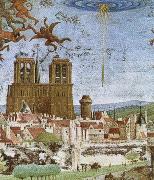 |
st ambrose
|
|
Milan; feast day December 7) Bishop of Milan. Raised in Rome, he became a Roman provincial governor. As a compromise candidate, he was unexpectedly elevated from unbaptized layman to bishop of Milan in 374. He established the medieval concept of the Christian emperor as subject to episcopal advice and censure when he forced the emperor Theodosius to seek forgiveness from the bishop, and he opposed tolerance for adherents of Arianism. He wrote theological treatises influenced by Greek philosophy, including On the Holy Spirit and On the Duties of Ministers, as well as a series of hymns. His brilliant sermons and personal example converted St. Augustine. |
|
|
|
|
|
staffan hallstrom
|
|
Staffan Hallström, född 1914 i Stockholm, död 1976, var en svensk målare och tecknare.
Staffan Hallström föräldrar var Gustaf Hallström, antikvarie vid Statens historiska museum och Astrid Hallström, född Berg. Han studerade på Gerlesborgsskolan, Tekniska skolan 1932-34 och vid Kungliga Konsthögskolan i Stockholm 1935-41 för bland annat Isaac Grenewald och Olle Hjortzberg 1935-41. Han företog studieresor till Frankrike, Italien, Nederländerna och Belgien.
Staffan Hallström bodde och arbetade under 1940-talet i Saltsjö-Duvnäs, där han hyrde rum av konstnären Olle Nyman. Han fick då kontakt med Evert Lundqvist, som inspirerade honom och gav honom stöd. Tillsammans med Olle Nyman, Evert Lundqvist och Roland Kempe ingick han i Saltsjö-Duvnäs-gruppen. Senare hade han även atelje på Varvsgatan och kombinerad bostad och atelje vid Brunkebergstorg.
År 1946 hade han sin debututställning på Konstnärshuset i Stockholm. Han slog igenom med utställningen Hundra målningar på Konstakademien 1961 och spåddes då lysande framtid framför allt av skulptören Torsten Renqvist.
Staffan Hallström, arbetade i nyexpressionistisk stil och bland hans mest kända verk är Ingens hundar från 1958, som köptes in av Moderna museet. Detta motiv målade han sedan i olika versioner. Tillsammans med Lasse Andreasson gestaltade han 1972 Masmos tunnelbanestation med verket Ta ned solen i tunnelbanan, målningar på plåt utefter spårväggarna. Han är representerad på bland annat Moderna och Nationalmuseum. .
|
|
|
|
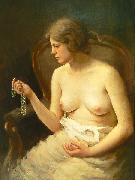 |
Stanislav Feikl
|
|
(November 12, 1883-January 7, 1933) was a Czech painter.
He studied at the School of Applied Arts and at the Prague Academy of Fine Arts. For inspiration, he toured Russia, Turkey, Dalmatia and northern Italy. He is known for his pictures of old Prague, rural areas and portraits of women, including naked. He painted impressionist paintings. |
|
|
|
 |
Stanislaw Chlebowski
|
|
(1835-1884) was a Polish painter with Russian and Turkish connections. He was a renowned specialist in oriental themes.
Chlebowski was born in Podole, and learned drawing in Odessa. Between 1853-1859, he studied at the Academy of Fine Arts in St. Petersburg, and then on a scholarship for six years in Paris as the pupil of the French orientalist painter Jean-Leon Gerôme. Chlebowski traveled to Spain, Italy, Germany, and Belgium. His first success was selling his painting "Joanne deArc in Amiens prisone to Napoleon III of France
In the years 1864-1876 Chlebowski was master painter for Sultan Abdelaziz and took up residence in Constantinople. Chlebowski became popular with the Sultanate. During his services, he had obtained permission to bring with him a large Icon of Mother of God Leading our Way having been rescued from a Odegon Monastry in 1453. He had come across it in one of the magasins with old relics, unheeded by the Ottoman keeper. This account is certified in a letter by Comite National Polonais a Constantinople, dated June 27, 1938.
In 1876 he moved to Paris. In 1881 he returned permanently to Krakow. The subject matter of his watercolors and oil paintings is diverse. He painted images of historical battles related to the history of Turkey, oriental genre scenes, landscapes, and portraits of Sultans. He died near Poznae in Kowanewko at age 49.
Chlebowski lived abroad for a long time and as a result his paintings were very rare in Poland. The National Museum in Krakow houses some of his other important Orientalist works such as "Entree de Mahomet II e Stamboul".
|
|
|
|
|
|
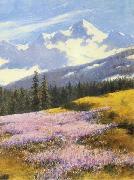 |
Stanislaw Witkiewicz
|
|
(8 May 1851 in Pašiaušė - 5 September 1915 in Lovran) was a Polish painter, architect, writer and art theoretician.
Witkiewicz was born in the Lithuanian village of Pašiaušė (Polish: Poszawsze) in Samogitia, at that time, in the partitioned Polish-Lithuanian Commonwealth lands ruled by the Russian Empire.
Witkiewicz studied in Saint Petersburg, 1869-71, then in Munich, 1872-75.
He created the Zakopane Style (styl zakopiaki) (also known as Witkiewicz Style (styl witkiewiczowski)) in architecture. He was strongly associated with Zakopane and promoted it in the art community.
His son, Stanisław Ignacy Witkiewicz, became a famous painter, playwright, novelist and philosopher, also known (from the conflation of his surname and middle name) by the mononymous pseudonym "Witkacy." The son's godmother was the internationally famous actress Helena Modjeska (Helena Modrzejewska), whom the elder Witkiewicz in 1876 had nearly accompanied to California in the United States.
Witkiewicz had strong views against formal education: "school is completely at odds with the psychological make-up of human beings". He applied this principle in his son's upbringing and was disappointed when the 20-year-old Witkacy chose to enroll at the Academy of Fine Arts in Krakew.
In 1908, suffering from tuberculosis, the elder Witkiewicz left his family in Zakopane and relocated to Lovranno, a fashionable resort in what was then Austria-Hungary, which today is in Croatia. He died there in 1915.
|
|
|
|
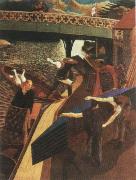 |
stanley spencer
|
|
English painter and daughtsman.
Spencer received his first formal training in 1907 at the Maidenhead Technical Institute, Berkshire. A year later he enrolled at the Slade School, London, where, as a day student nicknamed 'Cookham' by his fellow students, he remained until 1912. In that year his painting the Nativity (London, U. Coll.) was awarded both the Melville Nettleship and the Composition prizes. It shows the wide range of his early influences, from 15th-century Renaissance painting to the Pre-Raphaelites and Post-Impressionism: just as Gauguin's Yellow Christ (1889; Buffalo, NY, Albright-Knox A.G.) was set in Pont Aven, Spencer's similarly Neo-primitive Holy Family is placed in Mill Lane, Cookham. By then Spencer had firmly established his birthplace at the centre of his spiritual universe. He wrote, 'When I left the Slade and went back to Cookham, I entered a kind of earthly paradise. Everything seemed fresh and to belong to the morning. My ideas were beginning to unfold in fine order when along comes the war and smashes everything.'
|
|
|
|
|
|
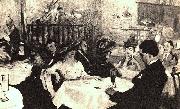 |
stefan Dimitrescu
|
|
(January 18, 1886 - May 22, 1933) was a Romanian Post-impressionist painter and draftsman.
Born in Huşi into a modest family, he completed his primary and secondary studies in his hometown. In 1902, deciding to follow his passion for music, he left for Iaşi, where he took cello classes at the Iaşi Conservatory.
In summer of 1903, Dimitrescu entered the National School of Fine Arts in the city, studying in the same class as Nicolae Tonitza; the two studied under Gheorghe Popovici and Emanoil Bardasare. After graduation, Dimitrescu painted murals for the Orthodox churches in Agăş and Asău (Bacău County). |
|
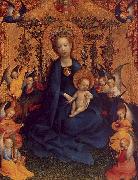 |
Stefan Lochner
|
|
German painter (b. ca. 1400, Meersburg am Bodensee, d. 1451, Köln |
|
|
|
|
|
 |
Stefano da Verona
|
|
Stefano da Verona. Dating to 1434, it is currently housed in the Pinacoteca di Brera of Milan, northern Italy.
|
|
|
|
|
|
|
|
|
|
|
|
|
|
|
|
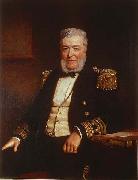 |
Stephen Pearce
|
|
(London, 1819-904) was a portrait and equestrian painter. Forty-four portraits which he painted are in the National Portrait Gallery in London, which also contains two self-portraits.
|
|
|
|
|
|
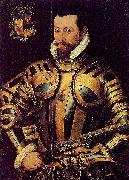 |
Steven van der Meulen
|
|
(b. eAntwerp - d. London, e1563-64) was a Dutch artist active c. 1543-1564. He gained prominence in England in the first decade of the reign of Elizabeth I as one of many Flemish artists active at the Tudor court. He is best known for the "Barrington Park" portrait type of Elizabeth I and for three-quarter length portraits of members of the English court in the first half of the 1560s. A recently discovered will indicates that he died in London between October 1563 and January 1564.
|
|
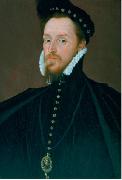 |
Steven van Herwijck
|
|
(Utrecht c. 1530-London 1565/67), was a Netherlandish sculptor and gem engraver famous for his portrait medallions and medals. It has recently been suggested that he is the "famous paynter Steven" mentioned in an inventory of 1590, who has traditionally been identified as Steven van der Meulen.
Van Herwijck worked in Italy in 1557 and returned to Utrecht in 1558, when he was made a Master of the artists' Guild of St. Luke. His earliest surviving medals, of George van Egmond, Bishop of Utrecht, and Engelken Tols, date from this year. In 1559 he relocated to Antwerp. Nine medals survive of his work there, including a portrait of Jacobus Fabius. Fleeing religious persecution, he went to Poland in 1561 where he made medallions of King Sigismund II and other members of the Polish royal family. |
|
|
|
 |
STRIGEL, Hans II
|
|
German painter, Swabian school (active 1450-1480 in Memmingen).
|
|
|
|
|
|
|
|
|
|
|
|
|







